Summary | Key concept | Science Story | Background Science | Activity | Curriculum links | Linked Activities
- Suggested Age Range: 10 – 11 years
- UK Primary Curriculum: Key Stage Two (upper)
- Suggested UK Year Group: Year 6
- UK Primary Curriculum Link: Light
- Science Subject: Aurora
- Science Question: What causes the aurora?
- Activity type: individual
- Suggested linked stories: Battle of the Northern Lights; The Land of the Northern Lights
Brief summary: The aurora is a truly spectacular visual phenomenonvisible close to the north and south poles of the Earth andoccurs because of an interaction between the Sun and the Earth. This activity introduces the reasons for the phenomenon and explores the visual appearance through art.
Key concept: The aurora happens as a result of an interaction of the Earth’s magnetic field and the solar wind coming from the Sun and is one aspect of space weather.
Key words: light, sky, solar wind, space weather
The Science Story:
What happens when you stand outside on a windy day?
When you stand in the wind you get blown about, your hair gets very tangled and you have to hold on to your hat to stop it being blown away. Wind happens on the Earth, but there is also a different kind of wind in space. The Sun creates a wind too, and blows out through the solar system past each of the planets in turn.
Do you know the order of the planets?
The planets are Mercury, Venus, Earth, Mars, Jupiter, Saturn, Uranus and Neptune.
How fast does wind blow on the Earth?
In the Earth’s atmosphere, the wind can blow from zero (on a very still day) up to about 250 kilometres per hour in a hurricane! Most cars travel at just over 100 kilometres per hour on the motorway, so this is pretty fast. The wind from the Sun is quite different to the wind on Earth, and it travels much faster, up to 800 kilometres per SECOND! That’s over ten thousand times faster than the fastest wind speed in a hurricane!
Could you stand up in a hurricane?
No, in a hurricane you would not be able to stand upright because the wind is so strong. The air on Earth is made of tiny particles and the wind feels strong because you are being hit by millions of these tiny particles and they all give you a slight push. You can’t feel these tiny pushes, but millions of tiny pushes add up to a feeling of one large push.
The Sun’s wind is much stronger than the Earth’s wind, and it carries a large number of tiny particles away from the Sun. When these particles from the Sun reach the Earth moving very fast, they hit our atmosphere with a lot of force and push on some of the particles in our atmosphere. The particles high up in our atmosphere get some energy from these solar particles, and they get excited and start vibrating quickly. Particles don’t like being excited, so they let go of some of this energy and relax, the energy is released as light which we see as colours in the sky called aurora.
Here is an Aurora video from BBC Newsround.
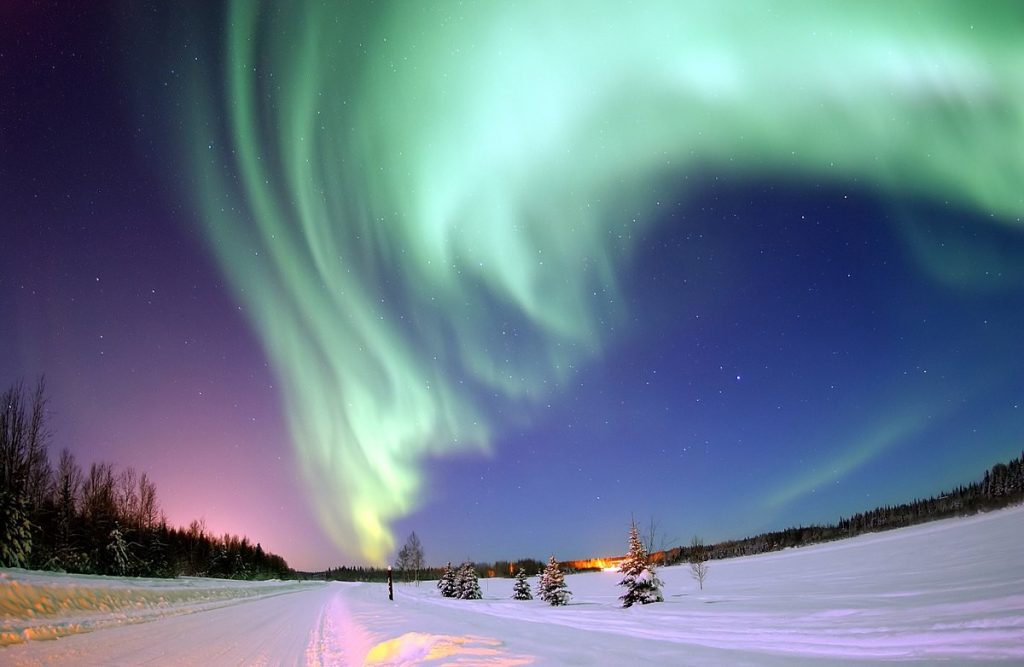
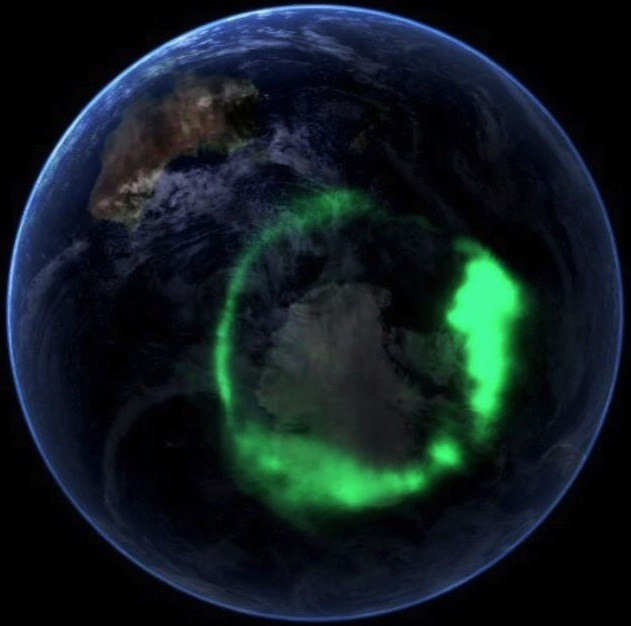
The Science: The science of the aurora is complex, and much is not fully understood. The aurora arises because of an interaction between the solar wind, and the magnetic field of the Earth. The Sun is a long way from the Earth, so far that even sunlight takes over eight minutes to travel the 150 million kilometres to the Earth.
The Sun produces all of the heat and light that makes the Earth such a perfect planet for life, but that is not all the Sun produces. The Sun is a star, like any other star in the sky. All stars generate heat and light, but they also each generate a stellar wind composed of energetic particles (protons and electrons). In the case of the Sun, we call this wind the solar wind.
Even though the Earth is 150 million kilometres away from the Sun, it is not outside the influence of this solar wind. The solar wind is in fact so strong that it is blowing a “bubble” in the thin gas that fills the galaxy around our Solar System. This “bubble” is much larger than the diameter of the Earth’s orbit, and in fact reaches far beyond the orbit of the outermost planet, Neptune.
While we describe the solar wind as being “strong”, it is a relative term. The wind from the Sun would not feel as strong as the wind on Earth, even though it is much faster, and this is because it is much less dense, there are far fewer particles per cubic metre than there are in the Earth’s atmosphere. We feel the wind because of pressure, and pressure is a measure of force per unit area. Large numbers of particles can produce a large force, even at low speeds, the more particles, the higher the pressure. This is why the solar wind does not “blow away” the Earth’s atmosphere, despite the particles moving at such high velocities.
The particles of the solar wind leave the surface of the Sun at high speed, but even so it travels much more slowly than the speed of light. Light travels at roughly 300,000 km/s, the solar wind travels at between 400 and 800 km/s – slow compared to light, but fast compared to everyday Earth speeds experienced by humans. Light from the Sun reaches the Earth in just over eight minutes, the solar wind takes between two and five days to reach us.
One of the first bits of evidence for the solar wind was from geomagnetic storms measured on the Earth, just a couple of days after major coronal mass ejections were observed on the Sun’s surface. Evidence that the solar wind is continuous throughout the Solar System comes from observations of comets; the fact that comet tails are observed to always point directly away from the Sun, no matter the direction of a comet’s travel, is because the solar wind is continuously pushing away the material leaving a comet’s surface.
While the finer details of aurora are still an active area of scientific investigation, the general principle is thought to be as follows. When the particles in this solar wind interact with the magnetic field of the Earth and can be accelerated. Some of these particles will be drawn into the magnetic field lines of the Earth and accelerated into the atmosphere. This results in ionisation and excitation of particles in the upper atmosphere, and this leads to the emission of photons which cause the lights and colours we see as aurora. Difference colours are caused by different gasses in the atmosphere, oxygen creating orange and green colours, while nitrogen causes blue and red photons.
The activity: Students will create their own artistic images of the aurora using simple materials. Each student needs a sheet of black paper for the background, the black represents the night sky. Students can use their paper in landscape or portrait orientation – encourage them to look at photographs of aurora to decide on their approach before they start (see visuals, above).
Props required:
- Black paper (for the background, one sheet per student)
- Reasonably thick white paper or card (for the guide, one sheet per student) – the same width as the long edge of the black paper
- Chalk or pastels of various colours (to create the aurora)
- Paper towels (a few per student)
- Scissors
- Paper of various other colours (for foreground – optional)
Safety note: Care should be taken with scissors when cutting the guide shapes, and students should be supervised.
- Take a sheet of thick paper or card. Carefully use the scissors to cut a wavy shape in the paper. This will be used as a guide to create your aurora patterns.
- Using a chalk or pastel, draw a thick line along the wavy edge of the thicker paper so that a lot of colour is deposited on the guide.
- Holding the guide still with one hand, use a paper towel to brush some of the colour away from you and onto the black paper – this should produce light streaks of colour on the black paper. You may need to add more chalk to the guide and continue brushing to get the desired effect.
- Carefully lift away the guide, and you should be left with an aurora-like pattern on the black paper.
- Repeat this several times, and using different colours, to create interesting aurora patterns.
- Experiment with mixing colours on the same guide to see what happens, or swap your guide with someone else to create different patterns.
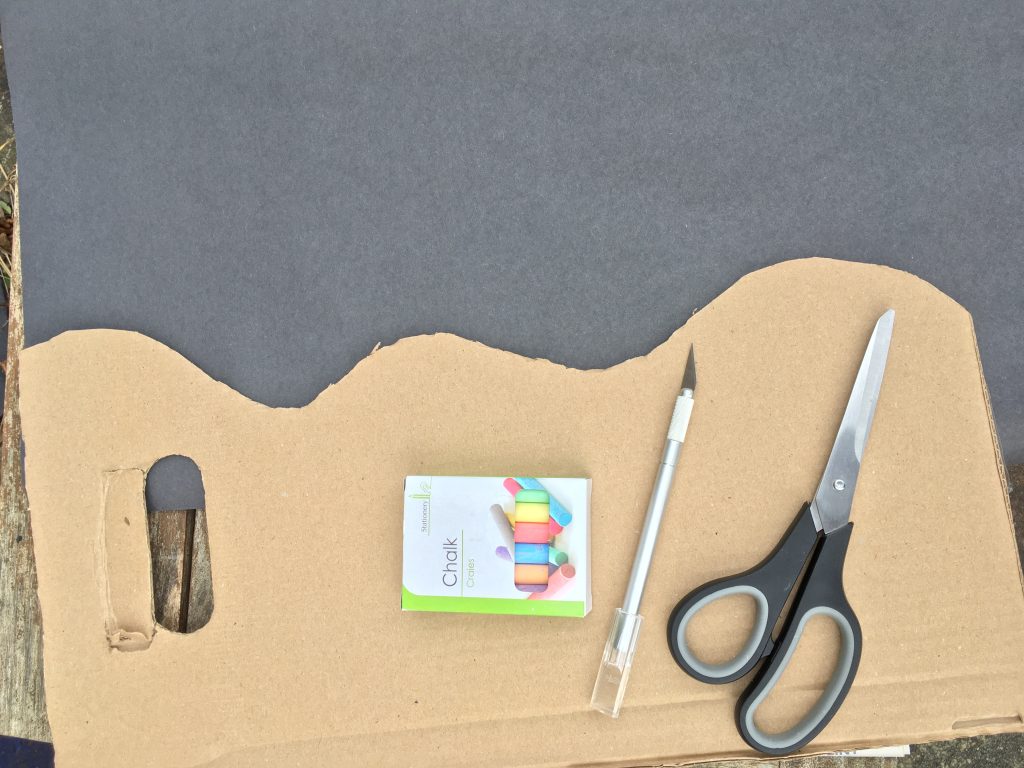
Step 1: cut a wavy shape in the stiff card to use as a template for the aurora. 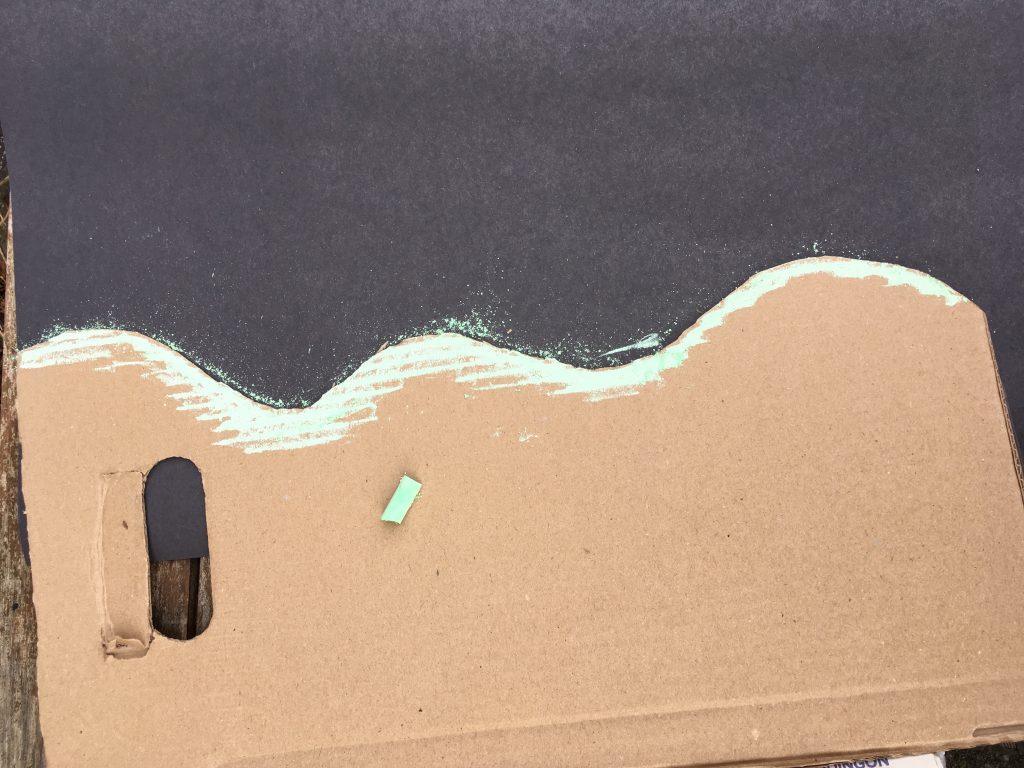
Step 2: use the chalk to cover the edge of the thick card. 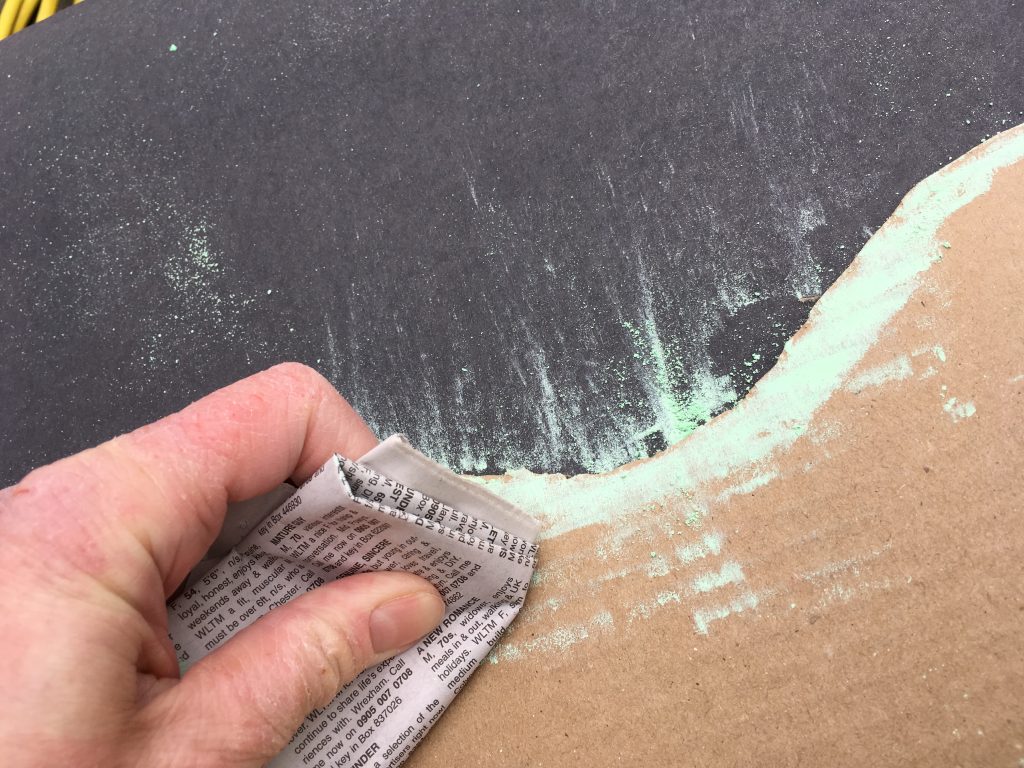
Step 3: Use a paper towel to brush chalk from the guide onto the paper. 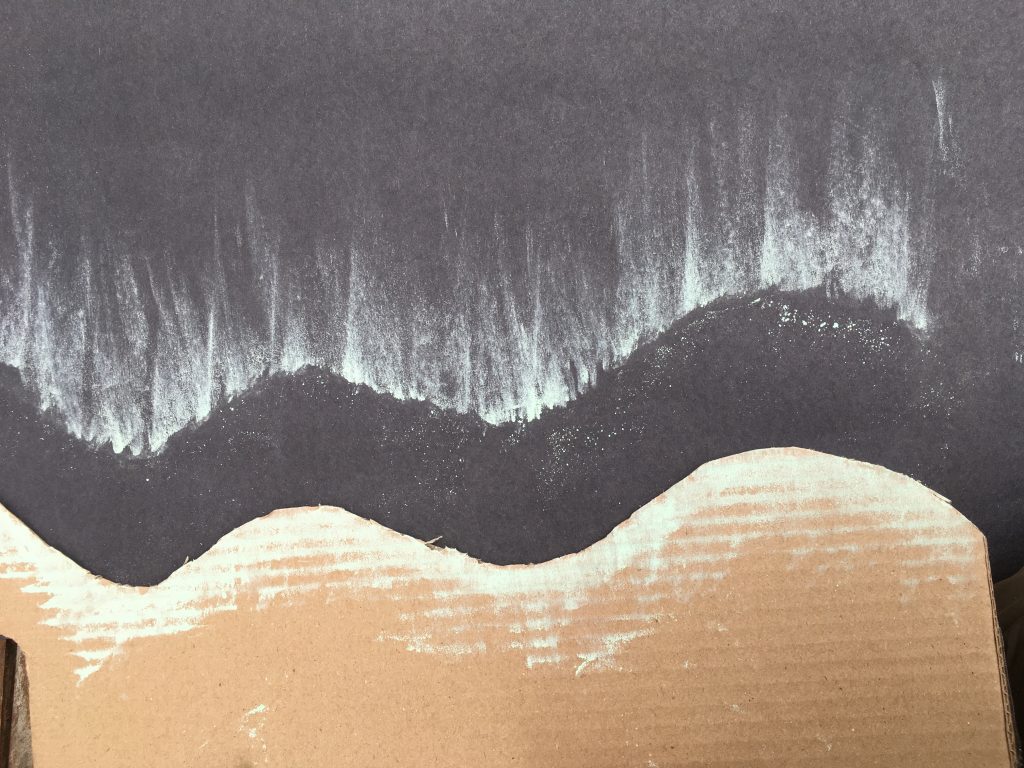
Step 4: remove the guide carefully leaving behind an aurora pattern. 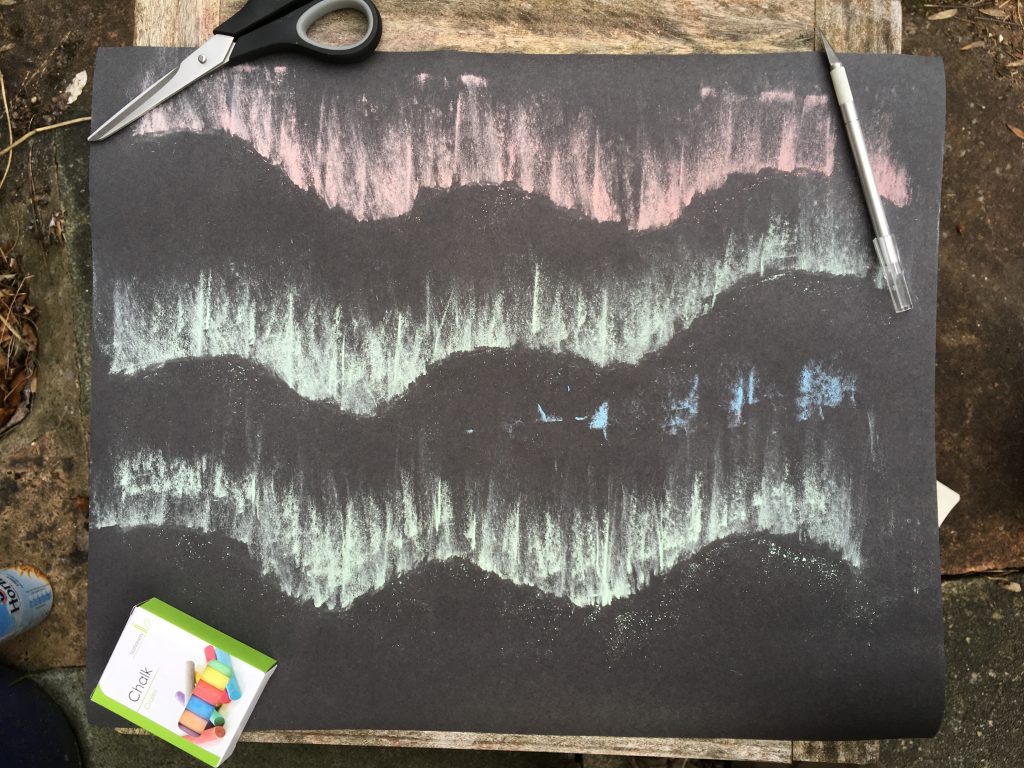
Step 5: repeat the process using the guide multiple times, using other colours of chalk if desired, to create your aurora display.
Internet searches can be used by the students to explore the visual appearance, shapes, patterns and colours that are often seen in photographs of the aurora. Students may also want to think about an interesting foreground image for their picture – aurora are often photographed over cabins, pines trees or mountains (common features of the landscape in regions where aurora commonly occur). This can bring in other aspects of art and mathematics such as perspective: the students will need to think about and discuss whether the aurora should be on top of or underneath the foreground additions to the picture. For correct perspective, the aurora should be in the background as the light comes from high up in the Earth’s atmosphere.
Extension: Students can be given further information on the effects of the solar wind and encouraged to research, write and present their own “space weather forecast” to the rest of the class, creating appropriate illustrations.
The UK’s Met Office provides space weather forecasts, and updates can be found on their website metoffice.gov.uk/space-weather and their twitter feed: https://twitter.com/MetOfficeSpace
This extension activity works well as a small-group activity.
Common misconceptions: The aurora is often called the “Northern Lights”, which is not incorrect but is geographically inaccurate since it also occurs in the southern hemisphere. When aurora occurs in the southern hemisphere it is also referred to as the “Southern Lights” or “Aurora Australis”. The distribution of human populations means that fewer people live in auroral zones in the southern hemisphere, so they are observed (and photographed) less frequently. An interesting fact is that the aurora is named after the Roman goddess who travelled from east to west each day, announcing the coming of the Sun.
Curriculum links:
- Geography KS2 locational knowledge – where the aurora can be seen around the world, from which countries and their common characteristics, population distributions.
- Geography KS1 human and physical geography – weather (extending to space weather) and its impact on human activities.
- Mathematics KS2 geometry – properties of 3D shapes
- Art and design KS2 – improve mastery of techniques
- Computing KS2 – use search technologies effectively
- English KS1 and KS2 spoken language (extension activity) – communicate information effectively and at an appropriate level
Linked activities:
Make your own Aurora – NASA
https://spaceplace.nasa.gov/pastel-aurora/en/
Northern lights activity book – NASA
https://image.gsfc.nasa.gov/poetry/activity/Nlbook_col.pdf
Other links:
Aurora video from BBC Newsround
https://www.bbc.co.uk/newsround/47417595
Video of the aurora as seen from the International Space Station
https://eol.jsc.nasa.gov/BeyondThePhotography/CrewEarthObservationsVideos/videos/slights_iss_20170817/slights_iss_20170817.mp4
Extended explanation of the Earth’s magnetic field
https://www.nasa.gov/mission_pages/sunearth/news/gallery/Earths-magneticfieldlines-dipole.html
Copyright: Megan Argo 2019





